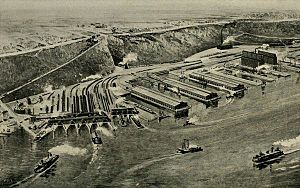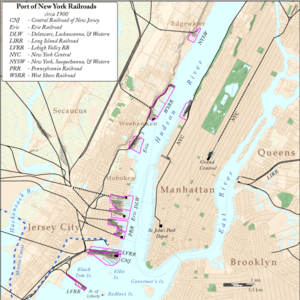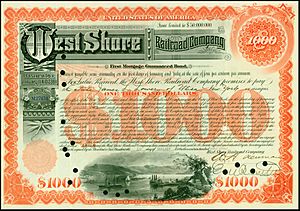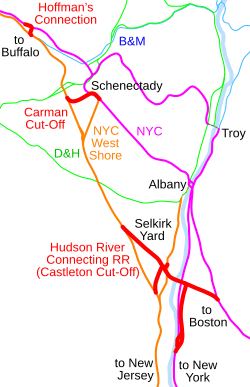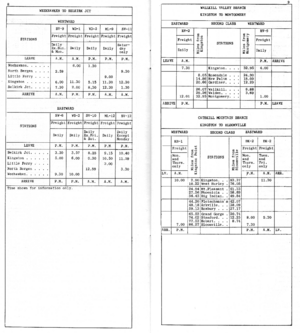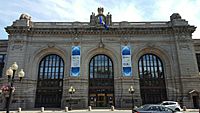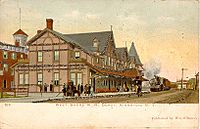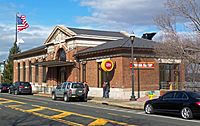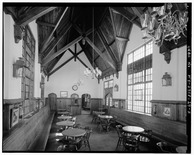West Shore Railroad facts for kids
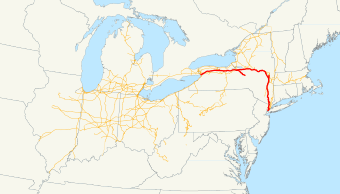
West Shore Railroad (red) and New York Central Railroad (orange) as of 1918
|
|
| Overview | |
|---|---|
| Locale | Weehawken, New Jersey Buffalo, New York |
| Dates of operation | April 16, 1864 (Saratoga and Hudson River Railroad) September 9, 1867 (New York Central Railroad) January 1, 1886 (West Shore Railroad) February 1, 1968 (Penn Central) April 1, 1976 (Conrail) June 1, 1999 (CSX Transportation)– |
| Technical | |
| Track gauge | 4 ft 8 1⁄2 in (1,435 mm) standard gauge |
The West Shore Railroad was a railway line that stretched from Weehawken, New Jersey, near New York City, all the way north to Albany, New York, and then west to Buffalo. It was built to compete with the famous New York Central Railroad, but the New York Central soon bought it.
Contents
History of the West Shore Railroad
The West Shore Railroad had a long and interesting history. It started as many smaller railway companies that eventually joined together.
Early Beginnings: Saratoga and Hudson River
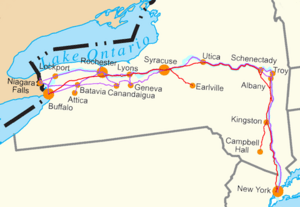
The very first part of this railway was the Saratoga and Hudson River Railroad. It was created on April 16, 1864. This line opened in the spring of 1866.
After only about a year, it became a branch of the New York Central Railroad (NYC). It split off near Schenectady and ran south along the west side of the Hudson River to Athens, New York. The New York Central bought this line on September 9, 1867.
The station in Athens was destroyed by fire in 1876. The line was used on and off until the 1880s, and its tracks were removed in 1888. People called it the "White Elephant" Railroad. This was because it quickly became useless. Today, a group of brick houses in Athens, built for the railway workers, is the only thing left from this project.
Building the Southern Sections
Another part of the future West Shore line started in the south. The Ridgefield Park Railroad was created on April 4, 1867. This line was planned to run north from Marion Junction in New Jersey. It would go past Ridgefield Park to the New York state line at Tappan, New York.
In New York, the Rockland Central Railroad was formed in 1870. It planned to continue the line to Haverstraw. Another company, the Rockland Central Extension, was created in 1872 to go even further north. These two companies merged in 1872. Then, they joined with the Ridgefield Park company in 1873. This new company was called the Jersey City and Albany Railroad. Its goal was to build a full line from Jersey City to Albany.
The line first opened in 1872. It was a small branch of the New Jersey Midland Railway. The section south of Ridgefield Park was built by them. The line reached Tappan first, and then extended north to Haverstraw in 1879.
Financial Troubles and New Mergers
The railway soon faced financial problems. The New York part of the line was sold in 1877. It was then reorganized as the Jersey City and Albany Railway in 1878. The New Jersey part was also sold and reorganized with the same name. In January 1879, the two companies merged to form one Jersey City and Albany Railway.
On April 3, 1880, the North River Railway was created. It planned to extend the line north to Albany. It also planned a branch to Schenectady. This company merged with the Jersey City and Albany in 1881. They formed the North River Railroad, planning a single line from Jersey City to Albany.
The West Shore Takes Shape
Two more companies, the Hudson River West Shore Railroad (1867) and the West Shore Hudson River Railroad (1867), also planned lines on the west side of the Hudson River. The New York, West Shore and Chicago Railroad was formed in 1870. It took over the West Shore Hudson River in 1877. This company planned a line not just to Albany, but also west to Buffalo.
This company was sold and reorganized as the New York, West Shore and Buffalo Railway in 1880. On June 14, 1881, the North River Railroad merged into it. This created one large company in charge of the entire route from New Jersey to Buffalo.
In 1883, the new company started passenger service. Trains ran between Newburgh and Jersey City. Passengers would then take ferries across the river.
A new path for the railway was built near North Bergen. By 1886, trains could reach Weehawken Terminal. This was possible thanks to a tunnel built under Bergen Hill over the previous three years.
The company also leased the Athens Branch from the New York Central Railroad. This was the old Saratoga and Hudson River Railroad line. It became part of the main West Shore line between Coxsackie and Fullers. At Ravena, the main line turned northwest towards Schenectady. A new branch continued north to Kenwood Junction in Albany. This full line was a big challenge to the New York Central's control.
Connections and Competition
The West Shore Railroad also had agreements with other railways. It could use tracks of the Suspension Bridge and Erie Junction Railroad and Erie International Railroad. This gave it a route from Buffalo to Ontario. However, after the New York Central took over, this route was not needed. The New York Central already had its own parallel line.
The West Shore also worked with the Boston, Hoosac Tunnel and Western Railway. This railway was supposed to run from the Hoosac Tunnel in Massachusetts west to Buffalo. But it only built tracks to Rotterdam Junction. This was west of Schenectady. Later, the Fitchburg Railroad and then the Boston and Maine Railroad took it over.
In 1881, the West Shore was planned as part of a new cross-country line. This line would go from New York to San Francisco. It would use several other railways. However, William Henry Vanderbilt of the New York Central bought one of these railways in 1882. This stopped the plan. The New York Central then started a fierce price war. This forced the New York, West Shore and Buffalo into bankruptcy. The West Shore could not afford to keep fighting.
The Pennsylvania Railroad (PRR) saw that the West Shore would be a great addition to its system. It would allow the PRR to reach deep into New York Central territory. At the same time, the New York Central was building a railway in Pennsylvania. This would go deep into the Pennsylvania Railroad's territory. A very damaging price war was about to begin.
A powerful financier named J.P. Morgan stepped in. He met with the presidents of both railroads. They agreed that the New York Central would buy the West Shore. In return, the New York Central would stop building its line in Pennsylvania. Parts of that unfinished line were later used for the Pennsylvania Turnpike in 1940.
The New York Central bought the New York, West Shore and Buffalo Railway on November 24, 1885. It then reorganized its new purchase as the West Shore Railroad on December 5. The New York Central leased it for 475 years starting January 1, 1886.
In many places, the West Shore line was straighter than the New York Central's own tracks. Because of this, the West Shore line was often used for long-distance freight trains. For example, between Oneida and Utica, the West Shore followed a straighter path.
Famous Trains and Stations
Several well-known passenger trains traveled north from Weehawken to Albany. These included the Storm King Limited and the West Pointer.
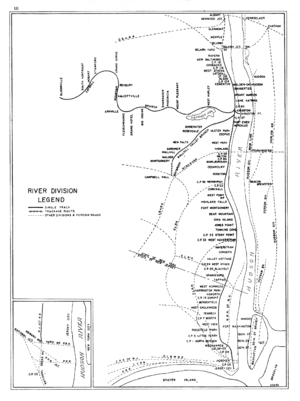
Major stops between Albany Union Station and Weehawken Terminal included many towns. These were Ravena, Coxsackie, Catskill, Saugerties, Kingston, Highland, Marlborough, Newburgh, Cornwall, West Point, Haverstraw, Congers, West Nyack, Orangeburg, and Tappan in New York. In New Jersey, stops included Dumont, Teaneck, Bogota, and Ridgefield Park.
Station Gallery
Current Use of the Line
Passenger train service on the West Shore line ended to Albany in 1958. It ended to West Haverstraw in 1959. This meant no more direct New York Central passenger trains on the west side of the Hudson River.
The line became part of Penn Central in 1968. Then, it went to Conrail in 1976 after Penn Central faced financial difficulties. When Conrail was split between CSX Transportation and Norfolk Southern in 1999, the West Shore Railroad became part of CSX.
Today, it is known as CSX's River Subdivision. This line starts west of the Hudson Palisades at North Bergen Yard in Hudson County, New Jersey. It goes north through Bergen County and Rockland County, New York. It continues up the west side of the Hudson River to Selkirk Yard. From there, trains can connect to places both west and east. South of North Bergen Yard, it connects to the Northern Running Track, which is part of Conrail. The tunnel under the Palisades is now used by the Hudson Bergen Light Rail.
West Shore Regional Proposal
In the late 1980s and early 1990s, New Jersey Transit became interested in bringing back passenger service to the West Shore line. This was because more and more people were using local bus lines.
In 1997, New Jersey Transit received a grant of almost $4 million. Many towns along the line supported the idea. They even changed their local rules to make space for new railway additions. Since New Jersey Transit does not own the current line, a new set of tracks would need to be built next to the existing freight line.
However, getting enough money was a problem. There were also disagreements with CSX. In the end, the focus shifted to other projects. These included the Northern Branch Corridor Project and the Meadowlands Rail Line (which was finished in 2009). There has been no official update on the West Shore project since then.


